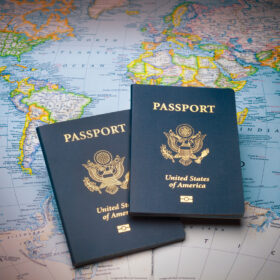Navigating REAL ID: What You Need to Know for Travel
Recent Blog
Ready to explore the world?
Post Tags
Navigating REAL ID: What You Need to Know for Travel
- Joseph Chanlatte
- Travel Planning, Travel Blogs
Travelers must obtain REAL ID-compliant identification for smooth domestic air travel. The new federal standard requires specific documentation, including birth certificates, social security cards, and proof of residency. A star-marked driver’s license or enhanced state ID meets federal requirements. Individuals can also use passports or passport cards as alternative identification. Additional details about maneuvering these complex identification protocols await curious travelers seeking thorough travel preparation strategies.
Table of Contents
ToggleKey Takeaways
- REAL ID requires specific documentation including birth certificates, social security cards, and proof of address for legal identification when traveling.
- Starting May 7, 2025, travelers must have a REAL ID-compliant driver’s license or alternative document (like a passport) to board domestic flights.
- A REAL ID-compliant license is identifiable by a star in the top right corner, signaling it meets federal security standards for air travel.
- Acceptable alternative identification methods include passport cards, enhanced state IDs, military IDs, and federal-issued documentation for seamless airport security screening.
- Travelers should verify their current identification’s compliance, gather required documents, and plan ahead to avoid potential travel disruptions at airport checkpoints.
Understanding REAL ID Requirements
Why do travelers need to understand REAL ID requirements? The REAL ID Act mandates specific documentation standards for obtaining government-issued identification.
Travelers seeking REAL ID benefits must prepare thorough documentation demonstrating legal presence and residency. The REAL ID application process requires multiple proofs of identity, including original documents like birth certificates, social security cards, and address verification.
Precise preparation prevents potential travel disruptions, ensuring smooth airport security screenings. By understanding these requirements, individuals can efficiently navigate the identification process, ultimately securing a REAL ID-compliant driver’s license marked with a distinctive star, enabling hassle-free domestic air travel.
Identifying Your Compliance Options
A labyrinth of identification options awaits travelers seeking seamless domestic air travel compliance. Steering through REAL ID benefits requires understanding multiple pathways, including traditional driver’s licenses with the distinctive star, enhanced state IDs, and alternative documents like passport cards.
Compliance challenges emerge from varied documentation requirements and individual circumstances. Individuals must carefully assess their current identification, weighing the convenience of a REAL ID-compliant license against alternative travel documents.
Strategic planning and early preparation can mitigate potential travel disruptions, ensuring smooth passage through airport security checkpoints nationwide.
Exploring Alternative Identification Methods
Travelers seeking alternatives to REAL ID encounter multiple pathways for identification verification.
Mobile ID and Enhanced ID provide convenient options for those unable to obtain a standard REAL ID. Mobile ID, a digital driver’s license, offers TSA-accepted identification in select states.
Enhanced ID, available in five states, combines driver’s license features with citizenship proof. These alternatives cater to individuals facing documentation challenges or preferring digital solutions.
While not universally accepted, they represent flexible approaches to meeting travel identification requirements, giving travelers additional choices beyond traditional REAL ID compliance methods.
Passport Solutions for Domestic and International Travel
Precisely how can individuals leverage passport solutions for seamless domestic and international travel?
Passport solutions offer travelers thorough identification and travel convenience:
- Online passport renewal simplifies the process for eligible travelers over 25.
- Passports serve as universal identification for both domestic and international journeys.
- Regular processing times of approximately six weeks enable strategic travel planning.
- Passport cards provide a compact alternative for domestic travel requirements.
Travelers can strategically choose between traditional passports and passport cards based on their specific travel needs, ensuring smooth border crossings and airport security experiences while maintaining flexible identification options.
Essential Travel Documentation Tips
Passport strategies seamlessly connect to broader travel documentation preparedness, highlighting the need for meticulous document management.
Travelers must anticipate potential identification challenges by maintaining current, valid credentials across multiple formats. Digital and physical copies of essential documents provide backup during unexpected scenarios, ensuring smooth transit through security checkpoints.
Advance preparation involves verifying document expiration dates, understanding specific destination requirements, and maintaining organized records of identification materials.
Proactive travelers minimize disruptions by cross-checking travel documentation against current governmental regulations, reducing potential complications during domestic and international journeys.
Travel is one of the best gifts I’ve ever given myself, and I want others to experience that same magic. If you’re a travel enthusiast, the faveplus travel site is an all-in-one guide packed with real, actionable steps to help you get out there and explore the world.










